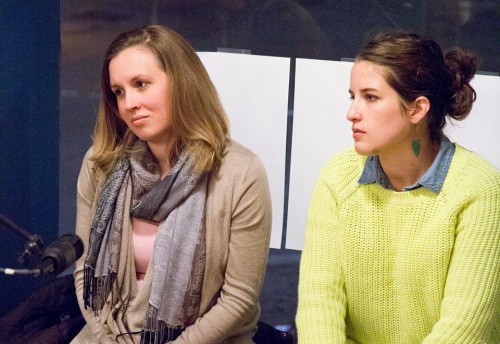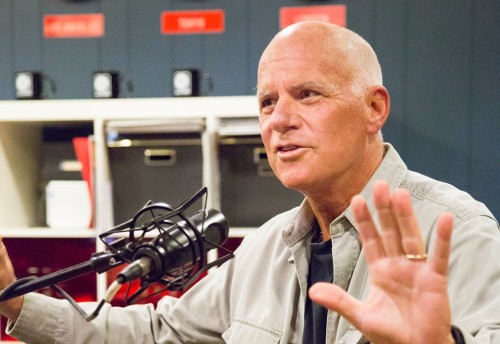HOMELESSNESS AMONG STUDENTS IN WASHTENAW COUNTY… After kicking things off with the awesome into song written by our recent guest Frank Allison, we jumped right into things with Eastern Michigan University student Ramone Williams, the subject of a recent investigative piece on homelessness among Michigan’s college students. Williams told us about the circumstances that lead to his homelessness, how he’s been able to maintain a 3.6 GPA while living in his grandmother’s van, and how his life has changed for the better since his story was made public by The Center for Michigan.
Williams, one of six homeless students presently receiving assistance through EMU’s MAGIC (Mentorship, Access, Guidance In College) program, talked at length about both the help he received prior to going public with his story, and the kindness which he’s encountered since. Williams said that he didn’t know what to expect when he decided to open up and share his story, but the experience has only been positive. According to Williams, he no longer feels invisible. People are saying hello to him on campus, offering to take him to lunch, and “friending” him on Facebook. Someone, after having read his story, even established a Go Fund Me page on his behalf, which has now brought in over $25,000. Williams, to his credit, is asking that people no longer contribute to the campaign, as he now has enough money to get an apartment and cover his expenses. He’s asking instead that people donate to the MAGIC program, so that they can continue to provide the kids of services that helped him make it this far.
[The above photo of Williams was taken just prior to our interview by photographer Chris Stranad as part of our Six Pack Portrait Project.]
After talking with Williams, we then continued our conversation on youth homelessness with high school senior Brittney Barros, who we first met this past summer on the episode of the Saturday Six Pack where we had local teens come it into the studio to talk with our Mayor, Chief of Police, Sheriff and Superintendent of Ypsi Community Schools about issues that mattered to them. Barros, as you might recall, after sharing her personal story of homelessness, asked our assembled guests how, in their jobs, they supported young people like her, who were homeless. Well, she came back during this episode to tell us more about both the seven months she was homeless, and the work she’s been doing ever since to make things better for young people who find themselves in the same position. [Barros is currently working with Washtenaw County teachers, helping them to better recognize students that might be dealing with housing instability, and encouraging them to be more empathetic in their treatment of these young people, who are dealing with things beyond their control.]
Barros, like Williams before her, talked a great deal about the kindness she’d encountered, and how, even during the worst of it, when she was living in a ditch, she tried to remain thankful. And I think that’s what most struck me about this segment with Williams and Barros. While their stories are certainly heart rending, neither of them seemed to let it let it slow them down. Williams did say that, when reading his story, as it was presented in The Bridge, it kind of hit him how tragic it all sounded. In his day to day life, though, he said he didn’t really think about it. He told us that he was just too focused on moving forward, doing what he had to do keep surviving, and making his way through college in hopes of landing a job. Whereas I think some might be tempted to dwell on how unfair life can be, both Barros and Williams were incredibly optimistic, telling us repeatedly about the good people that they had encountered. Barros also talked at length about how, even when she was living outside, caring for her addicted mother, and having to wear soiled clothes to school, she made it a practice to be grateful, reminding herself that, even if she were just eating one meal a day, she was still better off than children in some countries, and, even though she may be living outside, at least she wasn’t suffering in a hospital bed.
I suspect that, for some people, this was the first time they’ve ever heard homeless people talking about their experiences, and I hope that maybe, as a result, they’re more inclined to treat people with generosity in the future. The truth is, there are many reasons why people are homeless, and a lot of folks out there, like Williams and Barros, are working their asses off, not just to make better lives for themselves, but for those who, like them, are struggling every day just to stay alive. It’s so important that we, as members of this society, hear these stories, and I’m glad that Barros and Williams made the decision to come forward and share their experiences in hopes of helping others.
Saying, “I found ways to be grateful,” Barros told us about all of the people who helped her along the way… the school counselors who bought her personal hygiene products, the woman who gave her a tent when she was living outside, and the people at Ozone House who hired her to do peer outreach work in the schools, making other homeless students aware of the resources that exist in the community.
Asked what she says to young people living in situations like the one she recently got out of, Barros [seen above] says she tells them that “nothing lasts forever,” and that they have the ability, if they want, to work hard and make a better life for themselves. [It’s probably worth noting that both Barros and Williams work multiple jobs in addition to going to school.]
[If you would like to listen to episode thirty-six of The Saturday Six Pack, you can either download it from iTunes or scroll the bottom of the page, where you’ll find the Soundcloud file embedded.]
In addition to Barros and Williams, we were also joined in the studio by Allie Schachter from Ozone House and Megan DeVoe from MAGIC, who talked not only about their individual programs, but other resources that exist in the community for those young people suffering from housing instability. [Our discussion begins at the 40 minute mark.] Here are just a few of those resources, in case you’d like to share them with anyone.
A great first step for any young person dealing with homelessness in Washtenaw County, would be to call the Ozone House crisis line: 734-662-2222
If a student is out of school, facing expulsion or suspension, or moving out of district (due to homelessness) and wants help staying in their school, or figuring out where they should go next, they should call our Student Rights Hotline at (734) 482-0489 or check out the website of The Student Advocacy Center.
If a student is living in a temporary situation, and is currently enrolled in school, they should ask their school social worker or principal who their district’s McKinney-Vento liaison is. This is someone who can help offer school supplies and other support. Or, they could call the Education Project for Homeless Youth at the Washtenaw Intermediate School District at 734-994-8100.
And students at EMU who have either experienced homelessness or foster care, can reach out to the MAGIC program. [As DeVoe would tell us during this segment, only 4% of those who have experienced foster care ever go on to graduate college. As that’s the case, there are 14 programs across the state that have been set up to help former foster children in college. Magic, however, is the only program in the state that also exists to support homeless college students.]
According to our guests, at least 1,400 young people in Washtenaw County have been identified as struggling with homelessness and housing instability. This is a huge issue and we’re incredibly fortunate as a community to have folks like Schachter and DeVoe [seen below], working on this issue every day.
THE POISONING OF FLINT… At the 52 minute mark, after playing a song written earlier that same morning our friend Pete Larson in Kenya called “Coming Down is Harder,” we began our conversation with Flint’s Lee Anne Walters, the woman who, perhaps more than anyone else, can be credited with bringing the Flint water crisis to the attention of the world.
Walters walked us through the events of the last 18 months, from the first signs of lead poisoning that she began to see in her children, to the point when a sympathetic EPA employee broke protocol and gave her a preliminary study of the toxic water running into her her home. We talk about her evolution as both a “citizen scientist” and activist, and what she’s doing now to ensure not only that the children of Flint get the care they need, but that those responsible for the cover-up are held to account for their actions.
My hope is to transcribe out conversation in the very near future, as it really deserves to be shared in more depth, but here are 10 points that stood out to me…
1. The health problems started in her family soon after the switch was made to Flint River water. Members of her family began losing their hair. She lost almost all of her eyelashes. Her son Gavin, who was born with a compromised immune system, was starting to have trouble walking, and his language skills seemed to be regressing. She says she started to put the pieces together when she noticed that his skin wold break out whenever he came in contact with the water. [And this was before the water started to come though their faucets discolored.] Walters said you could literally see the line on his body, upon leaving the tub, dividing the half of his body that had been submerged, and the half that was out of the water. Her son has since been diagnosed with both lead poisoning and anemia. He will turn five in March, she says, and he still only weighs 35 pounds. [And it should be noted that her family has been drinking, cooking and bathing with only bottled water for the past year, so he’s still suffering from his early exposure.] When asked why she stays in Flint and fights, Walters told me, “It’s too late for my child, but what about the rest of them?”
2. Walters says she wasn’t political before this, but that all changed when her family’s health began to be effected. She tells of the early months when her pleas for action were not just being ignored by the powers that be, but met with accusations. When she started showing up at meetings with jugs of her water, which, by that point, had turned a yellowish brown, she says she was called a “liar” for trying to pass the samples off as having come from her tap, and “stupid” for attempting to fool authorities. She was accused of having an “agenda.” Speaking of these public meetings, Walters says that they started being moved from City Hall to smaller locations around the city that not only held fewer people, but did not require that city personnel be sworn in.
3. We talked about the lead testing that had been done by the City and the EPA at her home. The lowest reading, she said, was 200 parts per billion. [Anything over 5 parts per billion is a problem according to the EPA.] The average reading was 2,500 parts per billion. And the highest reading was 13,200 parts per billion. Professor Marc Edwards of Virginia Tech, who studies lead in drink water, said that he’d never seen a level that high in all his 25 years of research. “It was literally hazardous waste levels,” he said. [Technically, hazardous waste begins at 5,000 parts per billion, Walters tells us.]
4. We talked about how, after she proved to the City that her son had lead poisoning, and they tested to confirm that lead was, in fact, in her water, they offered to change the service line coming into her home from the water main outside. This, they told her, would likely solve the problem, as it was probably her service line that was lead. All she had to do, she was told, was sign a document stating that she would never attempt to hold anyone accountable for what had happened to her son or other members of their family. When Walters told then that she wouldn’t sign, they then accused her of being a bad mother, who didn’t care enough about the safety of her family to have the lead issue resolved… She didn’t give in to their coercion, though, and they eventually replaced her service line, which, by the way, turned out not to be lead.
5. At some point in all of back and forth with the City, Walters says, someone had the bright idea to solve the problem by running a garden hose from her neighbor’s house to hers. [Apparently their lead levels weren’t as high.] This, she says, went on for over six weeks, during which time members of her family came down with a rare staff infection.
6. We talked about how she, professor Edwards and others coordinated a “citizen testing” campaign across the city, funded by a National Science Foundation grant. It was this campaign, which yielded 277 samples, that proved conclusively, according to Walters, “the problem was in every single zip code, and not just my home.”
7. Walters says that, when she first talked with the EPA, and mentioned that Flint had not implemented corrosion control when the decision was made to start delivering water from the Flint River to people’s homes, they told her that she had to be wrong. When she shared her research with them, proving that no corrosion control was in place, in violation of the EPA’s Lead and Copper Rule, she said they were flabbergasted.
8. Walters said that people who point out that the Flint City Council voted to support the Emergency Manager’s idea to transition away from Detroit water, and have a new pipeline built from Lake Huron, don’t know what they’re talking about. “The City Council had no power” at the time, she said. Furthermore, she says, people who point to that first City Council vote invariably refuse to mention the fact that, in April of 2015, the same City Council members also voted to go back to Detroit water, only to have their vote dismissed by the Snyder-appointed Emergency Manager. [Detroit water wouldn’t be restored until October.]
9. Walters told us that she’s convinced there was a coverup for at least a year. She believes that documents FOIA’d by Marc Edwards prove that people in power knew as early as the summer of 2014 that the water was poison, and yet they did nothing. “They knew and said nothing,” she told me. And, as a result, the children, old people and pets continued to drink the water and grow more ill. Instead of finding the source of the lead, the MEDQ, according to Walters, expended their resources discrediting the doctors and scientists who were coming forward to warn their fellow citizens… If the MEDQ used their resources to “look for the lead, instead of trying to hide it,” she says, it wouldn’t have come to this… And, yes, she says, she has been contacted by the U.S. Attorney’s Office, who announced their formal investigation last week.
10. This problem is bigger than just Flint, she told me. The EPA’s Lead and Copper Rule, despite the issue in Flint, and the one in D.C. about a decade ago, is continuing to be weakened. If, after what had happened in D.C., she said, they’d made the Lead and Copper Rule stronger, we never would have seen this happen in Flint. Instead, however, they broadened the “loopholes,” giving cities more ways to keep their lead numbers low, like allowing them to flush water lines before collecting samples, and letting them use certain bottles that are known to give more favorable results. And it’s getting worse, she said. According to Walters, we’re going to see more stories like this in the future.
Oh, and you can be sure that we also talked about both the falsifying records and deleting samples, and Snyder’s repeated suggestion that these children in Flint with lead poisoning may have become ill, not because of the water, but because they’d been consuming lead paint chips. [“My kid’s not sitting around eating freakin’ paint chips,” Walters says.]
[above: Lee Anne Walters of Flint, co-founder of Water You Fighting For?]
THE HISTORY OF ROCK… During our last segment, we were joined by musician-turned-entrepreneur Stefan Graf, the founder of both Ypsilanti’s Illuminart and Belleville’s Fantasee Lighting. While we didn’t have a lot of time, we did talk a bit about the seven years he spent touring with Grand Funk Railroad, the time his band opened for Led Zeppelin at the Grande Ballroom, and fortuitous events that led him to where he is today, doing things like creating custom lighting systems for Keith Richards.
If I remember correctly, Graf said his first big break came when he was asked, because he had a truck that could haul it, to help build a PA for Grand Funk. From there, he said he just kept his eyes open, learned as much as he could, and kept looking for opportunities. Eventually all of the pieces would start falling together while watching the band Yes, who had come to America with a theatrical lighting system unlike anything anyone in the states had seen before. Graf, seeing the opportunity, pitched Grand Funk on the idea of doing something similar, and the rest, as they say, is history.
If you enjoyed our conversation, stay tuned. Part two will be coming your way soon. I promise.
Thanks, as always, to AM 1700 for hosting the show, Kate de Fuccio for documenting everything with her camera, and Brian Robb for running the board, making sure the bills paid, and insuring that the toilet paper and bleach stays stocked. [All photos above, except for the one of Williams, come courtesy of Kate.]
If you like this episode, check out our archive of past shows at iTunes. And do please leave a review if you have the time, OK? It’s nice to know that people are listening, and, unless you call in, that’s pretty much the only way we know.
Now, if you haven’t already, please listen for yourself, and experience the magic firsthand… Oh, and tell you friends. This is an episode that they should experience.


















4 Comments
It took me forever to get this posted, and I’d like to apologize to everyone involved. Sorry about that.
It was a powerful show.
Ramone Williams’ story has made it to the Washington Post.
“Homeless student stops donations and asks people to help others”
https://www.washingtonpost.com/news/grade-point/wp/2016/02/03/homeless-student-stops-donations-and-asks-people-to-help-others/
Ramone Williams graduated from EMU this past Sunday.
From The Bridge:
The doors of the Eastern Michigan University Convocation Center opened at 7 a.m. Sunday, and by 8, cars were bumper-to-bumper along Hewitt Road trying to squeeze into crowded parking lots. Fathers in suits carried cameras and mothers cradled bouquets.
Two miles away, Ramone Williams walked alone out of an apartment carrying a backpack. Just a few months ago, that backpack had held much of the 26-year-old’s possessions – a few changes of clothes, a can of Chunky soup, bags of tea.
Sunday, the backpack held a cap and gown.
Until a few months ago Williams was homeless, a college senior at Eastern Michigan who had enough money for college tuition or a home, but not both. He attended classes by day, and slept in his 2007 Grand Caravan at night. When the weather turned cold, he slept in the EMU library and showered in the student recreational facility.
Sunday, Williams walked across campus for the last time, arriving at the Convocation Center just in time for the graduation ceremony, where he received a bachelor’s degree in communication media and theatre arts. It was a long walk on streets that had worn out several pairs of sneakers, part of an even longer journey for a young man too stubborn to quit.
“I sacrificed a lot to get here,” Williams said. “It’s worth it.”
http://bridgemi.com/2016/04/for-inspirational-homeless-student-graduation-day/
8 Trackbacks
[…] Saturday evening. Tomorrow’s show will be in four parts. First, we’ll be continuing our ongoing coverage of the Flint water crisis with ACLU Michigan’s investigative reporter Curt Guyette. Then, we’ll be talking with […]
[…] Saturday evening. This weekend’s show will be in four parts. First, we will be continuing our ongoing coverage of the Flint water crisis with ACLU Michigan’s investigative reporter Curt Guyette. Then, we’ll be talking with […]
[…] of Flint’s citizens, including Virginia Tech Professor Marc Edwards and Flint resident Lee Anne Walters. While most of the local coverage, I suspect, will focus on Congressman Jason Chaffetz’s […]
[…] month or so ago, we had local entrepreneur Steffan Graf of on the show, talking about his life on the road with Grand Funk Railroad, and how he went from opening for Led […]
[…] month or so ago, we had local entrepreneur Steffan Graf of on the show, talking about his life on the road with Grand Funk Railroad, and how he went from opening for Led […]
[…] call Walters, the co-founder of Water You Fighting For?, at her home in Flint. Walters, who during episode 36 of the Saturday Six Pack, walked us through the events of the last 18 months, from the first signs of lead poisoning that […]
[…] I arranged, with the help of our mutual friend Steffan Graf, to have Grammy Award-winning musician Ivan Král on the show, I had a pretty good sense of what I […]
[…] the 45 minute mark, I called Flint water activist Lee Anne Walters, who we’ve talked with on the show before, and asked her what it was like to testify before Congress. Here impression, she says, based on […]